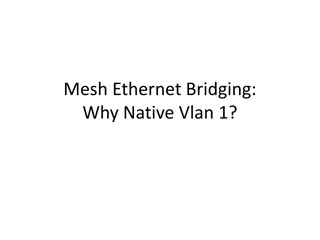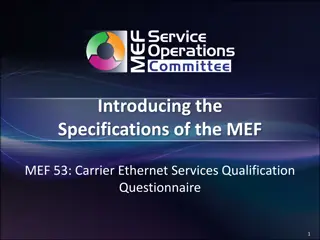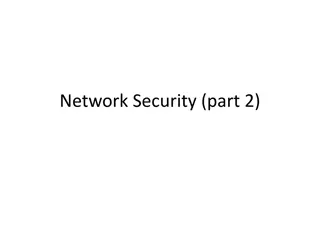Campus Mail Services Package Shipping Tutorial
This tutorial guides you through the process of creating your ship request, validating return addresses, entering recipient addresses, verifying recipient addresses, providing package information, selecting a carrier, entering your cost account number, printing the ship request form, and attaching i
4 views • 8 slides
Understanding TCP/IP Networking Tools in Linux Administration
The iproute2 software suite in Linux provides utilities for network control and monitoring, replacing legacy tools like ifconfig, netstat, route, and arp. This lesson delves into displaying information about network interfaces, network addresses (IP addresses), routing tables, assigned DNS servers,
2 views • 22 slides
HPE 665249-B21 Ethernet 10Gb 2-Port 560SFP Network Adapter
Refurbished | HPE 665249-B21 | Ethernet 10Gb 2-Port 560SFP Network Adapter | \u2713 FREE and FAST Ground Shipping across the U.S. | Best Price Guaranteed\n\nProduct Link: \/\/ \/hpe-665249-b21-ethernet-10gb-2-port-560sfp-network-adapter\/
0 views • 1 slides
Understanding Bluetooth Low Energy Addresses in IEEE 802.11-21/1535r0
The document explores the features of resolvable addresses in Bluetooth Low Energy (BLE) within the IEEE 802.11-21/1535r0 standard. It discusses the two types of addresses in BLE, Public and Random, and their usage. The emphasis is on Random addresses due to their popularity and privacy features. Th
2 views • 11 slides
Metro Ethernet Market Report Opportunities, and Forecast By 2033
According to the Regional Research Reports, the global Metro Ethernet market is expected to project a double-digit CAGR during the forecast period (2024-2033). The report provides an in-depth analysis of the market size (Euro\/USD Million) and volume (units\/tons). This analysis has been systematica
1 views • 8 slides
Neo.Go Mobile Application Integration Settings
This guide provides detailed instructions for integrating the Neo.Go mobile application with Neo security system panels using Ethernet or Cellular communication. It covers programming steps, data plan considerations, and settings for both Cellular and Ethernet communications. Ensure a proper data pl
0 views • 26 slides
Understanding IPv4 Addresses and Classful Addressing in Computer Networks
Explore the basics of IPv4 addresses, address space, hierarchy in addressing, and classful addressing in computer networks. Learn about the unique 32-bit structure of IPv4 addresses, address space calculation, notation methods, and the hierarchical nature of network addressing. Dive into the concept
2 views • 14 slides
IEEE 802.11-20/0054r1 MLD MAC Address and WM Address
In the document IEEE 802.11-20/0054r1, the focus is on Multi-Link Framework for MLD address identification and differentiation. It explains the usage of MLD MAC address and STA WM medium address in wireless setups. The document also addresses the need for identifying different MLDs using MAC address
0 views • 16 slides
MAAP Protocol Overview in IEEE 1722: Address Acquisition and Message Format
The MAAP (Multicast Address Acquisition Protocol) is defined in IEEE 1722 for time-sensitive applications in bridged local area networks. It involves acquiring multicast addresses through claiming, probing, and defending messages. MAAP enables dynamic allocation of addresses and defending against co
1 views • 8 slides
Guide to Creating Access from Wired to Wireless Devices Using Airborne AP Ethernet Bridge
Explore a comprehensive guide on setting up access from wired to wireless devices using Airborne AP Ethernet Role Bridge. Learn how to connect a PLC and a wireless laptop to the same network, configure settings for both devices, and successfully ping between the devices. Follow step-by-step instruct
2 views • 7 slides
Understanding Native VLAN 1 in Mesh Ethernet Bridging
Mesh Ethernet bridging utilizes native VLAN 1 for the initial configuration, ensuring the RAP connects to the native VLAN ID 1 on a switch. This setup affects the communication between the RAP and the Map devices, as well as their connection to the controller. Misconfigurations related to VLAN taggi
0 views • 9 slides
Overview of Approved MEF Specifications for Carrier Ethernet Services
This document introduces the approved MEF specifications related to Carrier Ethernet services, focusing on MEF 53 - Carrier Ethernet Services Qualification Questionnaire. It outlines the purpose, audience, documents, terminology, use cases, and business process flow of these specifications. The MEF
1 views • 15 slides
Enhancing Privacy with Randomized MAC Addresses in 802.11 Networks
This presentation discusses the use of randomized MAC addresses as a privacy-enhancing measure in 802.11 networks. Passive observation of MAC addresses poses privacy risks, and the proposal suggests assigning random MAC addresses to portable devices to mitigate tracking risks. By periodically changi
0 views • 10 slides
Boosting Home Networking Speed with Ethernet over Coaxial Technology
Enhance your home network speed with Ethernet over Coaxial (EoC) technology, reaching up to 2.5Gbps for efficient streaming and internet access. This cutting-edge solution allows for high-definition video streaming, simultaneous device connectivity, and seamless integration with existing coaxial inf
0 views • 11 slides
Understanding Local Area Networks (LAN) and IEEE Project 802
A Local Area Network (LAN) is a computer network designed for limited geographic areas, often interconnected with wide area networks (WANs) or the Internet. IEEE Project 802 established standards for LAN protocols, focusing on the physical and data link layers. Ethernet emerged as the dominant LAN t
0 views • 27 slides
DirectLOGIC Communications Training Overview
Explore the technical training communications for Do-more DirectLOGIC systems, focusing on setting up communication between DL Servers and Clients using built-in Ethernet ports and ECOM100 modules. Learn about communication configurations, memory allocation, and parameter settings to establish effec
0 views • 28 slides
Real-time Ethernet on IEEE 802.3 Networks Tutorial
This tutorial focuses on IEEE standards for real-time Ethernet networks, enabling deterministic delivery time for applications in industrial automation and automotive control. Key topics include IEEE 802.1 Time Sensitive Networking and P802.3br Interspersing Express Traffic projects, aiming to meet
0 views • 61 slides
Optimizing Ethernet Communication with PRP and HSR Redundancy Protocols
Explore how to optimize Ethernet communication using Parallel Redundancy Protocol (PRP) and High-availability Seamless Redundancy (HSR) protocols. PRP is ideal for connecting a large number of IEDs with the same application, while HSR is preferred for smaller networks with a single ring topology. Di
0 views • 23 slides
Understanding LAN Interconnection and Switching Technologies
This content delves into the concepts of interconnecting LANs, exploring the reasons and methods behind partitioning LANs and interconnecting them at different layers using repeaters, hubs, bridges, switches, and routers. It also highlights the differences between these devices in terms of their net
0 views • 21 slides
Fundamentals of Data Link Layer and Ethernet in Computer Networks
Delve into the essential concepts of the Data Link Layer and Ethernet in computer networking, covering services like framing, error detection, correction, reliable delivery, and more. Explore how frames transfer data between nodes, the importance of link protocols, and the role of MAC protocols in l
0 views • 46 slides
Standards Development for Radio over Ethernet in IEEE1904
Explore the ongoing standards development for Radio over Ethernet in IEEE1904, including the PAR submission, approval process, and key objectives such as encapsulation and mappers. Learn about the RoE encapsulation overview, PAR content, what's not part of the PAR, and more regarding this cutting-ed
0 views • 9 slides
Performance Characterization of a 10-Gigabit Ethernet TOE
The Network Based Computing Laboratory at Ohio State University and Los Alamos National Lab conducted a study on the performance of a 10-Gigabit Ethernet TCP Offload Engine (TOE). The research highlights the advancements and technology trends in Ethernet infrastructure, focusing on achieving higher
0 views • 21 slides
Understanding Data Link Layer in Computer Networking
Explore the important concepts of the Data Link Layer including Ethernet addresses, Media Access Control (MAC), Controlled Access, and Contention. Learn how these elements control the transmission of data in computer networks and impact network performance based on traffic conditions.
0 views • 24 slides
IEEE 802.11-21/1585r10: Identifiable Random MAC Address Presentation Summary
This presentation discusses the concept of Identifiable Random MAC (IRM) addresses in the IEEE 802.11-21/1585r10 standard. It covers the purpose of IRM addresses in preventing third-party tracking while allowing trusted parties to identify specific devices. The presentation outlines the use of Ident
0 views • 24 slides
Addressing Privacy Concerns in IEEE 802.11-21: Changing MAC Addresses for Improved Security
The document discusses the implications of changing STA MAC addresses per association in IEEE 802.11-21 standard to enhance privacy and security. It explores the challenges of maintaining persistent identifiers in data frames and the risks associated with sending source/destination addresses in clea
0 views • 11 slides
Contact Information and Email Addresses
This content provides a list of contact information and email addresses for various individuals. It includes details such as email addresses, websites, and names. It emphasizes the importance of checking for updates in the school newsletter and emails. The information is presented in a structured fo
0 views • 22 slides
Understanding Ethernet and Multiple Access Protocols in Computer Networks
Exploring the fundamentals of Ethernet and multiple access protocols in computer networks, this content discusses the two primary categories of multiple access protocols - contention access and controlled access. It delves into topics such as CSMA/CD, LANs, performance of multiple access schemes, ad
0 views • 7 slides
Understanding LAN Technologies and Subnetting in Networking
Subnetting involves dividing larger networks into smaller subnets by borrowing bits from HOST bits. This process does not increase the number of hosts but instead decreases hosts by losing two host IP addresses for each subnet. Different LAN technologies like Ethernet and Token Ring are used in netw
0 views • 23 slides
Understanding IP Addressing in Computer Networks
IP addressing provides a seamless network for users by abstracting and providing a uniform addressing scheme used by higher-layer protocols and applications. IP addresses identify connections rather than specific computers, with IPv4 using 32-bit integers and IPv6 using 128-bit addresses. The divisi
0 views • 19 slides
Local MAC Address Assignment Protocol (LAAP) and 802.1CQ
The Local MAC Address Assignment Protocol (LAAP) in conjunction with 802.1CQ specifies protocols and procedures for locally unique assignment of MAC addresses in IEEE 802 networks. LAAP operates in two modes - Server Mode and Peer-to-Peer Mode, ensuring efficient allocation of MAC addresses while av
0 views • 15 slides
Guide to Amending Ethernet Orders with BT Wholesale Online
This guide provides confidential information on amending Ethernet orders with BT Wholesale Online. It covers pre-requisites, how to search for and initiate an order, making amendments, and discarding changes. The new journey accessed via Business Zone offers improved navigation, layout, and compatib
0 views • 18 slides
High Performance User-Level Sockets over Gigabit Ethernet
Presentation overview of the design challenges, performance enhancement techniques, and results related to implementing high-performance user-level sockets over Gigabit Ethernet networks. The background and motivation discuss the limitations of traditional kernel-based implementations and the need f
1 views • 34 slides
Privacy Address Requirements for Wireless Personal Area Networks
This document discusses the privacy address requirements for IEEE P802.15 Working Group's TG4ab standard for Wireless Personal Area Networks (WPANs). It covers the need for 48-bit addresses with collision resistance, the use of different privacy addresses for each frame, and the adequacy of 12-bit c
0 views • 8 slides
Ethernet PHY Registers Tool Operation
The Ethernet PHY Registers Tool provides a simple way to read and write PHY registers using MDC/MDIO, aiding in development and issue debugging. This tool requires the Ethernet PHY to be connected with MDIO/MDC and initialized in a Linux environment. Pre-built binaries and source code are provided f
0 views • 9 slides
IEEE 802.11-22/0955r0 TGbh Pre-association Schemes Exploration
The document explores the pre-association schemes NGID, MAAD, and IRM within the IEEE 802.11-22 standard. It discusses how the schemes operate, comparing RRCM to MAAD and IRM, and addresses the use of Probes and MAC addresses in pre-association scenarios. The presentation clarifies the allocation of
0 views • 15 slides
Understanding Network Security Part 2: Link Layer and ARP
Exploring the vulnerabilities in simple network topologies with hubs and the need for examining the link layer to prevent eavesdropping. Dive into MAC addresses, ARP (Address Resolution Protocol), and how machines translate IP addresses to physical Ethernet addresses. Learn about ARP tables, the tra
0 views • 61 slides
Understanding IP Addresses and Their Classification
IP Addresses, short for Internet Protocol addresses, are unique identifiers assigned to devices on a network. They can be IPv4 or IPv6, with IPv4 having 32 bits and IPv6 being 128 bits. IP addresses are classified into classes A, B, and C, each with specific range and usage. Understanding IP address
0 views • 14 slides
Understanding Network Addresses and IP Addressing Schemes
Exploring the concept of network addresses, IP address allocation, prefixes, and packet forwarding in computer networks. Addressing requirements, the simplest solutions, IPv4 addressing, Ethernet frames, and hierarchical IP addressing schemes are covered in detail.
0 views • 25 slides
Understanding Address Resolution Protocol (ARP) in Computer Networks
Address Resolution Protocol (ARP) is essential for translating IP addresses to MAC addresses in computer networks. ARP facilitates communication between devices on the same network by resolving addresses and enabling efficient data transmission. This protocol involves message exchanges, hardware bro
0 views • 20 slides
IPv6 Public Policy Considerations - Addressing the Global IP Address Shortage
In light of the global shortage of IPv4 addresses, there is a pressing need for a fair policy for the allocation of remaining addresses. The rapid growth of the Internet has further increased demand for IP addresses, with IPv4 expected to run out soon. The deployment of IPv6 has become a critical is
0 views • 23 slides







































